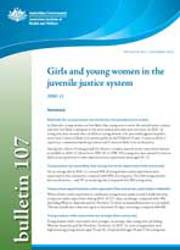Girls and young women in the juvenile justice system
Citation
AIHW
Australian Institute of Health and Welfare (2012) Girls and young women in the juvenile justice system, AIHW, Australian Government, accessed 25 April 2024.
APA
Australian Institute of Health and Welfare. (2012). Girls and young women in the juvenile justice system. Canberra: AIHW.
MLA
Australian Institute of Health and Welfare. Girls and young women in the juvenile justice system. AIHW, 2012.
Vancouver
Australian Institute of Health and Welfare. Girls and young women in the juvenile justice system. Canberra: AIHW; 2012.
Harvard
Australian Institute of Health and Welfare 2012, Girls and young women in the juvenile justice system, AIHW, Canberra.
PDF | 1.3Mb
In 2010-11, there were 1,190 young women under juvenile justice supervision in Australia on an average day and 2,620 during the year. Most (93%) young women were supervised in the community, with the remainder in detention. Young women spent around 2 weeks less than young men under supervision, on average, during 2010-11 (171 days compared with 186), which was mainly due to less time spent in detention (31 days compared with 68). Young women were much less likely than their male counterparts to be involved in all elements of the juvenile justice system.
- ISBN: 978-1-74249-361-9
- Cat. no: AUS 162
- Pages: 32
-
Young women were much less likely than young men to be involved in all elements of the juvenile justice system
-
Most (93%) young women were supervised in the community in 2010–11, compared with 85% of young men
-
Young women spent around 2 weeks less than young men under supervision, on average, during 2010-11
-
Over the 5-year period to 2010–11, rates of young women under supervision increased



